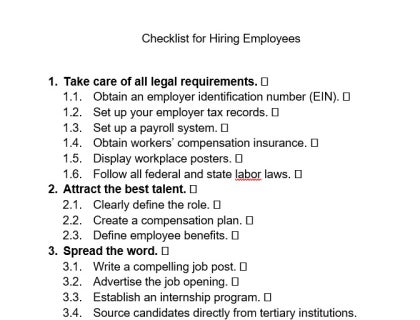
How to Hire Employees — Checklist
Use our PDF checklist as a guide for hiring new employees.
Download NowHow to Hire an Employee:

A step-by-step guide to hiring employees. Includes a full hiring process that will help you find and hire the best employees fast.
Take care of all the legal requirements.
Obtain an employer identification number (EIN).
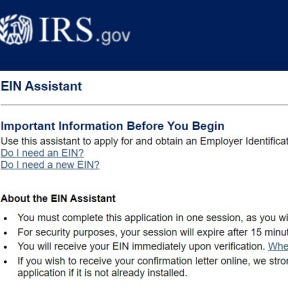
Before you hire employees, you will need an Employer Identification Number (EIN). This is like a Social Security number for your business which you will need in order to pay state and federal taxes. You may already have an EIN if your business is registered as a partnership or corporation.
Apply for your EIN online via the IRS website.
Set up your employment tax records.
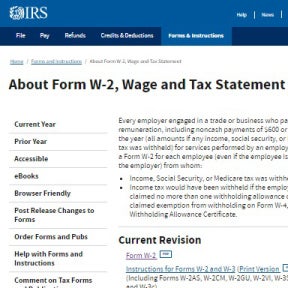
As an employer, you are required to keep your employment tax records for a period of 4 years after filing. Well-organized records will make it easier to prepare your tax returns and track business growth.
Employers are responsible for completing and filing a W-2 federal wage and tax statement form for each employee. The form must be given to your employees and Copy A should be sent to the Social Security Administration by the end of February each year for wages and taxes withheld from the previous year.
Read section 9 on page 21 of the Employer's Tax Guide to find out more.
Have employees fill out form W-4 so you can withhold the correct amount of federal tax from their pay.
Most states also have a state withholding form that must be submitted annually. Visit your secretary of state's website to find out more about your requirements.
Set up a payroll system.

Before you hire your first employee, you will need to set up a payroll system to pay them and process taxes. You have the option of doing payroll yourself using free payroll software or you can outsource your payroll to save time and ensure compliance with government regulations.
Obtain workers' compensation insurance.

The requirements for workers' compensation insurance varies from state to state. Most states require employers to obtain an insurance policy for workers who become ill or are injured during normal duties. Workers' compensation ensures that workers get medical attention and compensation for a portion of lost income if they are not able to return to work for a period of time.
Visit your state's workers' compensation department website to find out what your requirements are. You can find a list of all the state workers' compensation officials on the U.S. Department of Labor's website.
Display workplace posters.
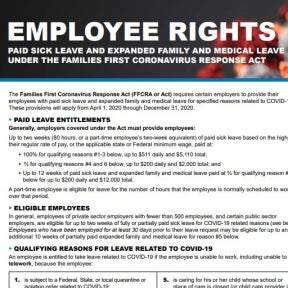
The department of labor requires that all employers display notices in the workplace informing employees of their rights. These posters can be obtained online free of charge and must be printed out and clearly displayed throughout the workplace.
Follow all federal and state labor laws.
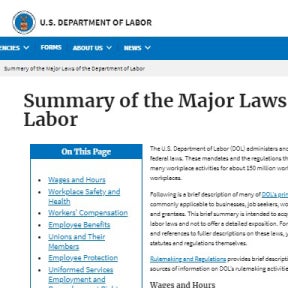
If you are hiring your first employee, make sure you comply with state and federal labor laws governing wages, health and safety, benefits, and unions. Failure to comply with employment laws is a federal violation and could result in legal action against you by your employee.
Visit your state labor office's website to learn more about the laws applicable in your state.
Visit the U.S. Department of Labor's website to read up on federal labor laws.
Attract the best talent.
Clearly define the role.

To attract the most suitable candidates, you have to clearly define what your needs are. Before you start recruiting, determine the type of support you require. Consider the full scope of your new hire's duties, from the basic tasks they will begin with, to the more advanced duties they will eventually complete.
From this information, you can figure out whether you will need a part-time or full-time employee and what employee skills and experience would best serve the role. Then create a list of job requirements to get a clear picture of what you should put in your job description.
Make a list of all the duties, requirements, perks, and limitations of the role.
Create a compensation plan.

Once you have clearly defined the role, you can put together a preliminary compensation package in line with industry expectations. If you are hiring your first employee, be sure to check out our complete guide.
Determine employee benefits.

Employee benefits play a significant role in attracting and retaining talent. Some employee benefits are required by law while others are at the discretion of the employer. The type of benefits you offer may depend on the number of employees you are planning to hire and what your budget allows.
Required benefits include:
- Social Security tax — employers are required to pay Social Security taxes at the same rate as their employees.
- Temporary disability insurance (TDI) — only required in California, Hawaii, New Jersey, New York, Rhode Island, and Puerto Rico.
- Workers' compensation — employers are required to provide workers' compensation to all staff members.
- Unemployment insurance — unemployment benefits vary by state. Check your state to see what programs are in place.
- Leave benefits — leave stipulated in the Family and Medical Leave Act (FMLA) is required by law. All other leave is at the discretion of the employer.
Voluntary benefits:
Supplemental benefits are employee benefits, products, or services provided by the employer but fully or partially funded by employees at a reduced group rate. A few examples of voluntary benefits include:
- Car insurance.
- Life insurance.
- Supplemental medical insurance.
- Dental insurance.
- Disability insurance (if not mandatory).
- Vision insurance.
- Homeowners insurance.
Spread the word.
Write a compelling job post.

Your job post should introduce your company, business, or institution, and clearly communicate the responsibilities, requirements, and limitations of the role. It is through the job post that most candidates will get to know you, so make a good impression and use this opportunity to really sell yourself to a potential hire. There are a few things that grab job seekers' attention, irrespective of the field they work in. If possible, try to offer a few of these.
Some things job seekers look for include:
- Comprehensive health benefits, including vision, dental, and life insurance.
- Paid vacation days and paid sick leave.
- Employee discounts and/or free products and services.
- A great retirement plan.
- Tuition subsidies.
- Free parking and meals.
- A gym membership.
- An employee wellness program.
- Wellness leave.
- Meaningful work and job satisfaction.
- Opportunities for growth and promotions.
You'll want your job posting to be enticing, but it is important to be honest with potential candidates. If there are unfavorable aspects of the job, such as evening or weekend shifts, be upfront about this. When you are transparent about job responsibilities, you have a greater chance of finding the ideal candidate.
Use one of our job description templates to help you craft the perfect job description.
Advertise the job opening.

Advertising your job opening is one of the most important parts of the recruitment process. If you want to attract the right candidates, you will need to advertise on multiple platforms. Posting on social media is a good way to start if you have an active social media profile for your business.
Posting your ad on job boards is another great way to attract top talent. Use our job posting template to easily create a posting that will speak to your audience. If you have a company website, you can also post your job ad online and use structured data to ensure it is indexed by Google for Jobs.
Depending on the job you're offering, you may be able to use traditional methods to get the word out, such as flyers and posters. These methods may be more effective when trying to attract candidates from a specific area or institution.
Establish an internship program.

An internship program is a great way to expand networks, groom new talent, and build relationships with potential hires. By starting an internship program, you can establish yourself as a trusted name in the industry and as a brand that creates opportunities for new graduates or other skilled workers.
An internship program isn't established overnight, but don't' underestimate the power of a great one! Once word spreads about the fantastic and innovative work you're doing with interns, job applications will start rolling in.
When you hire an intern, you already know their quality of work, potential, personality, and ability to fit in with your team, so internships may minimize recruitment costs in the long run.
Source candidates directly from tertiary institutions.

Creating pipelines from vocational schools, colleges, universities, and training programs will give you the first pick of new talent and help you keep up to date with advancements in your field.
Creating mentorship programs with students from vocational schools, colleges, and universities will help you groom potential hires and ensure that they meet your requirements when they apply for a job.
Vet your candidates.
Send a screening email.

Once your posting is out, you should start receiving some applications. The easiest and most effective way to deal with the flood of applications is to send out a screening email to each applicant. Your email can be a simple "Thank you for applying" letter with next steps, or a passive screening system with a few basic questions about the job to weed out unqualified candidates.
Conduct remote screening interviews.

Once you have narrowed down your list of candidates, you should conduct a short phone or online interview with each candidate to confirm their credentials and get a general sense of them as a potential employee. After this initial round of interviews, you should have a good idea of which candidates to invite for a final interview.
Use the phone or online screening interview to confirm the answers to the email screening questions. Any inconsistencies may be red flags.
Conduct a background check.

Before you conduct full-length interviews with top candidates, it is a good idea to run a background check to confirm employment history, current and previous address, and check criminal records.
Always obtain permission from candidates before making use of a background check service or conducting your own background check.
Conduct full-length interviews.

At this point in the recruitment process, you should have a final list of candidates with the right skills and experience to do the job. By conducting a full-length interview, you can get a sense of their personality, expose potential red flags, reveal the candidate's strengths, and ensure the candidate is an overall good fit for your company.
If you've invited the candidate to your office or institution for the interview, use this opportunity to give them a tour and to introduce them to staff. Pay close attention to their interactions with staff members and make a note of candidates who have natural chemistry with your team.
Take the time to address any questions or concerns, and also reiterate benefits of the job they are most interested in.
Consult our comprehensive list of interview questions for ideas of what to ask.
Do a paid test.

After the final interview, you may want to conduct pre-employment testing or test out your candidate on the job before you make an offer to hire. Doing a paid test has become common practice in many industries as it gives you an accurate idea of what the candidate is like in your work environment. Ideally, you will want them to be doing tasks that are representative of their daily duties, although this may only be possible once they have undergone orientation.
Hire your new employee.
Make an offer of employment.

After conducting final interviews and doing a paid test, you should have a final candidate list. Now it is time to make an offer of employment. If they accept your job offer, send them the employment contract to sign and new hire forms to complete for their first day on the job.
Check eligibility to work in the U.S.
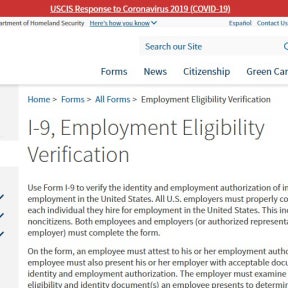
It is your responsibility as an employer to ensure that all of your employees are legally allowed to work in the United States. If you hire someone without employment eligibility, you could face a hefty fine or criminal charges.
Employment eligibility is confirmed when an employee fills out an I-9 Employment Eligibility Verification form before or on the first day of work.
Report new hires to the state.
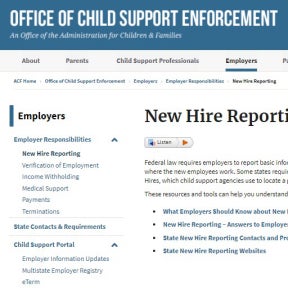
Federal law requires employers to report all new hires. If you hire a new employee or rehire a former employee, you are responsible for reporting your new hire to the state. The information is used by child support agencies to issue an income withholding order to a parent owing child support.
Complete orientation and onboarding.

When your employee arrives for their first day of work, you will most likely need to conduct orientation to integrate them into the workplace, introduce them to their work colleagues, and fill in any outstanding paperwork. Employee onboarding procedures will continue for up to 30 days, or until the employee is fully integrated and working to a satisfactory standard.
Report payroll taxes to the IRS.
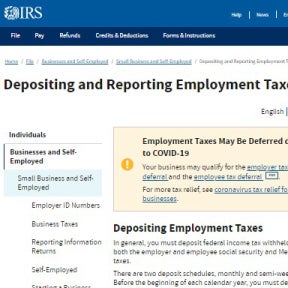
When you pay your employees, be sure to deposit and report your employment taxes to the IRS. Payroll software and service providers can automate the process to ensure you remain compliant.


